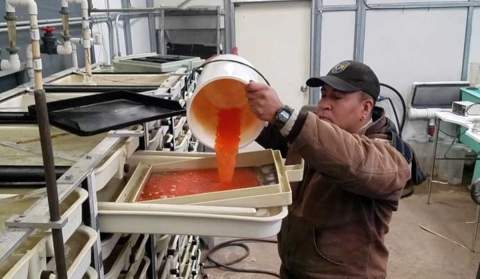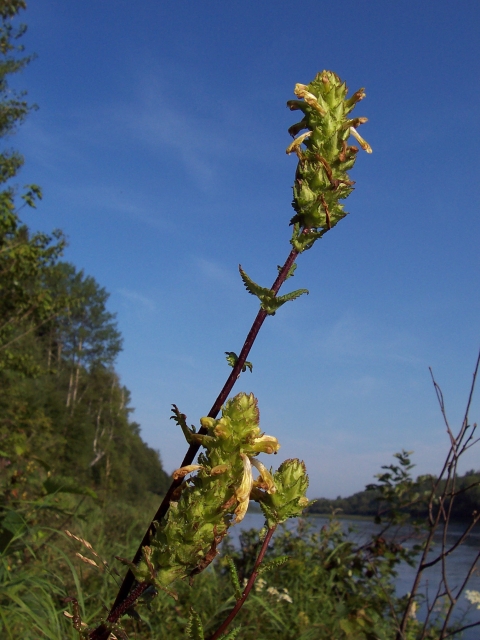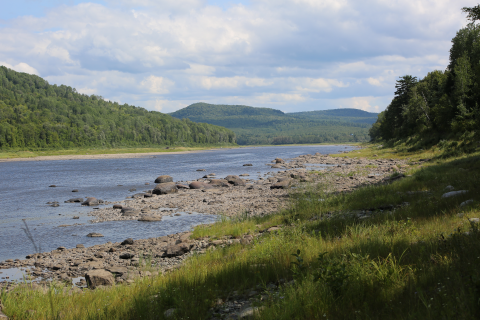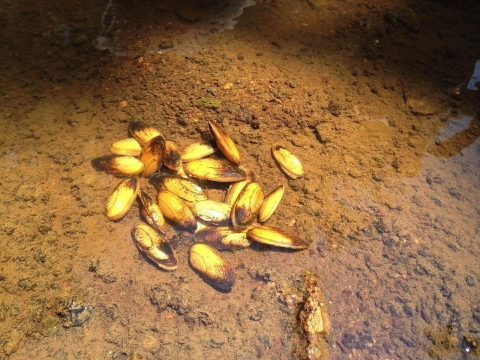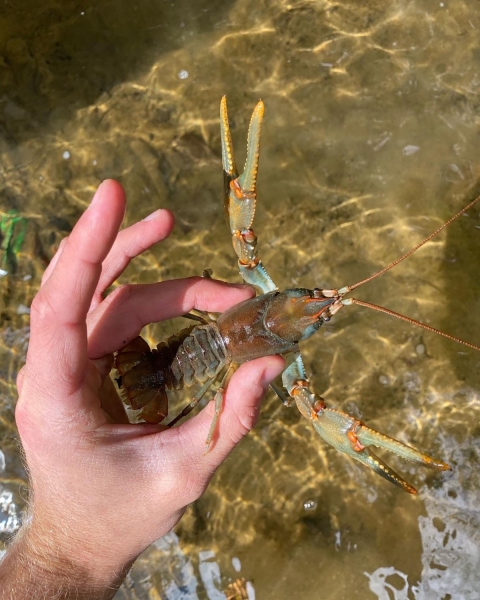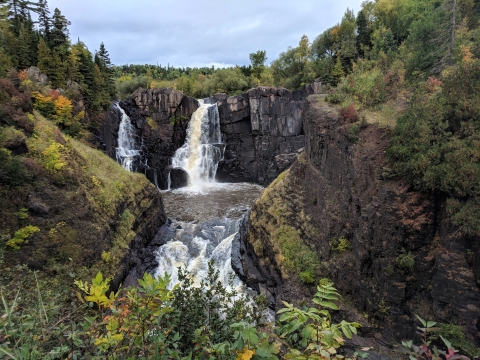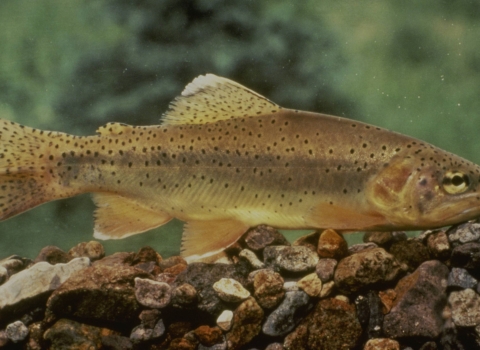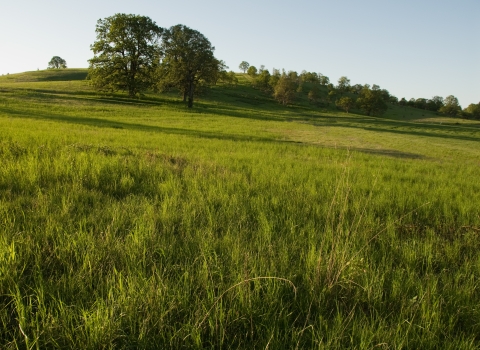Have you ever heard about a species being added to the endangered list and thought, what is that? You’re not alone. Many listed species are not only small but have narrow ranges. So why go through all the work of assessing, listing and working to recover a species that most people will never see?
Because even the smallest species can spark an explosion of creative solutions, collaborative opportunities and habitat restoration that lead to big conservation wins—for wildlife and people!
Casting a wide net(work)
It may seem like there’s plenty of fish in the stream in the White Mountains of Arizona. With bass, walleye, pike, and five different species of trout, the cold-water Black, White, Little Colorado, and Colorado river basins seem to be swarmed with scales.
Why then are biologists hard at work restoring the population of rare Apache trout that exclusively inhabit these streams?
Catching an Apache trout is the goal of many traveling sport fishermen, and the resulting tourism has become a major source of income for the White Mountain Apache Tribe. Bradley Clarkson, Tribe member and fisheries biologist with the Service, estimates that for every dollar put into the local hatchery, the nearby communities make nineteen.
Truly invaluable, however, is the partnership spawned by this stream-dweller.
The Apache trout was among the first species to gain federal protection under the Endangered Species Act (ESA) of 1973. It was the White Mountain Apache Tribe, however, who took the first steps to preserve this golden fish.
Recognizing the species’ decline, the Tribe closed fishing in all reservation waterways that contained Apache trout in 1955. They managed timber harvest, constructed non-native fish barriers and began removing invasive trout species.
Today, the White Mountain Apache Tribe continues to lead efforts to conserve and protect this special fish. The primary mission of Williams Creek National Fish Hatchery, on the Fort Apache Indian Reservation near McNary, Arizona, is to rear Apache trout. As the species faces threats from predation, invasive species invasive species
An invasive species is any plant or animal that has spread or been introduced into a new area where they are, or could, cause harm to the environment, economy, or human, animal, or plant health. Their unwelcome presence can destroy ecosystems and cost millions of dollars.
Learn more about invasive species and habitat degradation, this rearing program has been critical for keeping local streams stocked with healthy trout.
“The Tribe has been leading conservation efforts since the beginning, and our place here is in a supportive role,” said project coordinator and supervisory fish biologist Zachary Jackson. “In everything that we do we're coordinating very closely with the White Mountain Apache Tribe Game and Fish Department. ... Without that partnership we wouldn't be able to save the species.”
This partnership creates a brighter future for the fish and the local community. Williams Creek National Fish Hatchery has a goal to integrate fisheries education into the local school system to inspire and recruit the next generation of conservation biologists.
An herb worth fighting for
Some small species provide a cause for people to rally around, like Furbish's lousewort.
This yellow, flowering, perennial herb that was one of the first plants protected under the ESA. Characterized by its narrow habitat range, Furbish’s lousewort is exclusively found on the bank of the St. John River in northern Maine.
These small sprouts caused a big commotion by helping make the case to cancel a proposed $227-million hydroelectric dam. Authorized in 1965, the 30-story Dickey-Lincoln Dam was set to be the largest public works project in New England. The proposal sparked heated debate, with local citizens, the Maine Natural Areas Program, Environment Canada and members of the forest products industry arguing against its construction.
Thought to be extinct, Furbish’s lousewort was rediscovered during studies to assess the potential environmental impact of the dam. Those opposed to the dam used this species as an example of the possible harm caused by a project of this magnitude. The ESA legally required public works to collaborate closely with the Service to offset any harm to the herb, effectively driving up the project price and workload.
Studies showed the project would have flooded more than 80,000 acres of Maine’s North Woods, destroying the endangered lousewort's habitat. In 1986, Congress deauthorized the proposal, stating that it would be too expensive both economically and environmentally to continue.
Thanks to the effort of partners to continue to protect this specie's habitat, the Service proposed to downlist Furbishes lousewort from endangered to threatened in 2021.
“Strong public-private conservation partnerships made it possible for the Furbish’s lousewort to regain ground,” said Aurelia Skipwith, then-director of the Service. “We commend private landowners for working with the state and the Service to conserve habitat for a unique plant that occupies a small but important place in our natural history.”
More mussels for stream strength
Even at two inches long, freshwater mussels helped push through sweeping legislation that protects drinking water for small towns and big cities.
In April 2021, the Service designated 319 river miles in Maryland, Virginia and North Carolina as critical habitat for the yellow lance mussel. That means federal agencies must consult with the Service to ensure that any activities they authorize, fund or carry out will not destroy or damage these waterways.
These protected miles overlap with the habitats of many other endangered aquatic animals that do not have critical habitat designations of their own. They include the Roanoke logperch, Tar River spinymussel, dwarf wedgemussel and James spinymussel.
With its bright yellow hue, the yellow lance mussel is easy to spot. Service biologist Sarah McRae calls it " a little golden gem.”
Its function is just as valuable. Freshwater mussels are remarkable water purifiers, vastly improving the quality of drinking water. A healthy bed of mussels in a stretch of river just two football fields long can effectively filter more than a half-million gallons of water each day.
They are the “livers of the rivers,” said fish and wildlife biologist Dr. Jennifer M. Archambault, referring to their ability to clean water using their filtration superpower. McRae added that they also are “canaries in a coal mine,” alluding to both their bright hue and their ability to indicate environmental danger.
As sedentary, filter-feeding species, mussels are sensitive to water-quality changes due to habitat degradation and pollution. Their absence not only directly affects water quality; it indicates potentially dangerous changes in our drinking water sources.
“In Maryland, conservation of yellow lance is a great example of how actions that help with the protection and persistence of a mussel can benefit others,” said Maryland Department of Natural Resources biologist Mathew Ashton. “The stream home to yellow lance flows into a river that feeds a water-supply reservoir for the Washington, D.C., metropolitan area, so efforts to reduce pollution from runoff or improve the riparian riparian
Definition of riparian habitat or riparian areas.
Learn more about riparian habitat can also benefit the public's water supply.”
Harboring healthy habitat
Mussels aren’t the only locally specific aquatic critter stirring up support. In March 2022, the Service designated 446 stream miles in Kentucky, Virginia and West Virginia as critical habitat for the threatened Big Sandy crayfish (named for the Big Sandy River) and the endangered Guyandotte River crayfish.
These blue, teal and turquoise crayfish are more than just pretty faces.
“They have all sorts of different roles in the ecosystem that they live in,” said Service fish and wildlife biologist Riley Aulick. “In the summer months they are predators feeding on macroinvertebrates, and in the colder months they are active shredders, processing leaves so that they can be broken down and the nutrients can then be used by organisms farther down the chain.”
In turn, these crayfish are eaten by larger predators, including fish, birds, reptiles, amphibians and mammals, making them an important link in the food chain. Like mussels, their absence not only indicates a decline in water quality but creates a dire gap in the stream ecosystem, threatening the health of the wildlife and people that rely on it.
“It’s really important that we conserve these smaller species, not only because they have been living here for as long as we have, but because it benefits the human species as a whole,” remarked Aulick. “They serve as a check and balance system for the health of our lands and waters. They indicate what actions are environmentally harmful so that we can adjust our activities in order to continue to be able to enjoy our natural resources.”
From motivating networks of conservation partners to safeguarding miles of streams, protection of even the tiniest of critters and the smallest of shrubs by the Endangered Species Act creates a cascade of change. Learn more about the unique endangered and threatened wildlife in your neighborhood by searching listed species by state.


